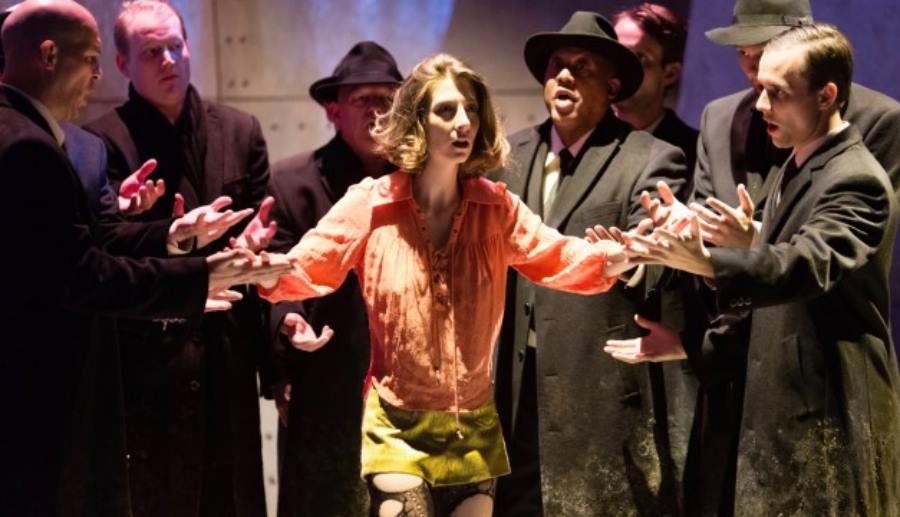I unexpectedly appeared in five productions at this year’s January experimental theatre festivals in New York. I have not given up my critic’s beat. It’s just that the artists in five offerings had me—along with other audience members—dance, move, sing, create, destroy, and take a bow to a digital ovation as part of the works. Hefty audience participation, interaction, and control were major themes in the festivals.
Cvrtain, a virtual reality show at the Coil Festival, was entirely driven by audience members’ behavior. Wearing VR goggles and holding hand-paddles, we each took a bow, and a digital audience roared with applause or didn’t. (They might even boo.) In 600 Highwaymen’s The Fever at Under the Radar, audience members had to mimic the movements of the performers: standing, gesturing, or, if you’re me, sashaying off the beat. Both Shasta Geaux Pop (UTR) and La Medea (Coil) asked audiences to move around dance-floor spaces.
Thankfully, most shows starred only professionals. Some came with a gentle approach, with whispers, silence, or images taking precedence over words. Others relied heavily on film as an added layer. As is often the case with live art, identity was probed through movement, music, and messages.
There are always artists heretofore unknown to me who become new favorites through the six major festivals (in addition to UTR and Coil they are Special Effects, American Realness, Prototype, and Exponential), which coincide with the annual APAP presenters conference. Among the highlights of the 26 shows I sampled this year:

Ghost Rings (American Realness): Structured around a “fake band” (Tina Satter, Chris Giarmo, Kristen Sieh, Erin Markey) and tales of Satter’s complicated relationship with her sister, Ghost Rings explores a variety of sisterhoods—relatives, friends, and romantic. With rock songs by Giarmo and Markey, vignettes with randy deer and seal puppets (!), and the intense relationship of two girls, Shauna (Sieh) and Samantha (Markey), this weirdly entrancing show drifts between musical numbers, narrated memories, and through-the-looking-glass oddity. In slumber party whispers, Shauna and Samantha speak their ardent devotion for each other. Details are blurry, yet the voices are emotionally potent. Is Shauna having Samantha’s baby because she willed it so? There’s definitely a baby-bump panda down the front of someone’s pantyhose. Satter’s piece feels like a page from a teenage diary covered in glittery stickers, lipstick kisses, love stories for that friend you want to be more, and thoughts of a sister who made you happy once.
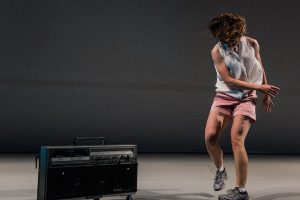
Piece for Person and Ghetto Blaster (Coil): Nicola Gunn’s movement performance about a moral conundrum, peace, and conflict was slippery. In her story, a woman encounters a man throwing rocks at a sitting duck, and the woman wonders: Should she take action? The rumination on this scene spins off into tendrils and tangents on Marina Abramović, Brief Encounter, temptation, consequence, ethics, and art. Gunn is not only making these quick mental flits but is also constantly moving in rhythmic, jagged, and twisted ways. Sometimes she lends voice to the woman, the man, and even the duck. Funny, frenetic, constantly changing and upending expectations, the enchanting piece probes, pokes, and never lingers long in any one spot. With a small woman, a boom box, a large space, and some gentle theatre magic, Piece envelops us and challenges how we see art, the world, violence, and each other.
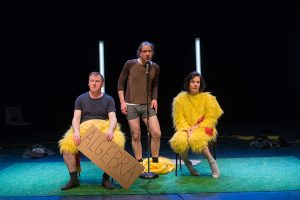
Real Magic (Coil): In the style of game show, with a host and presenter, a blindfolded contestant must guess the word the presenter is holding up on a sign for the audience to see. After three failed guesses, the three Forced Entertainment actors (one dressed as a chicken) swap roles and costumes. The routine repeats with the same result; the correct answer is not guessed. But even with repetition, it is not identical. There are ebullient, rapid-fire renditions with boisterous laugh tracks. There are slow, dark, painful episodes where each wrong answer feels like a wound. The longer this goes on, the more desperate the performers become (as well as the audience—the people I saw it with shouted out the “correct” word in vain). Anticipation of release from this merry-go-round weighs with each cycle. This was the first work I saw post-election that had me viewing it through a political lens: Even when truth was in plain sight, on a visible sign right in front of the contestant, it still was not spoken.
Worktable (Coil): Kate McIntosh’s installation piece depended on participant choices. Faced with a wall of thrift shop objects, you select one; then, at a personal worktable, you either destroy it, take it apart, or wear it down. Wearing safety goggles and protective head gear I could still hear loud hammering from the rooms around me. I worked up a sweat trying to crack open a sturdy camera from the 1970s. Next you have to put a different object back together again. Creativity, ingenuity, and patience all come into play. As my mallet dented the camera I wished it was not my job to destroy it. But there was redemption in rebuilding. I carefully put back together a small globe like it was a puzzle; my reconstruction was literal. Others found ways to create something new and beautiful from shattered pieces of ceramic figurines, typewriters, and tin toys.
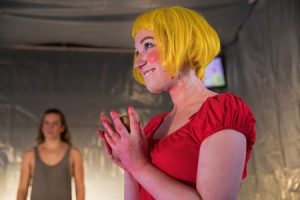
Blankland! (Exponential): This production by Boom Bat Gesture is a good example of the darkly comedic nuttiness you might enjoy at this Brooklyn-based festival, now in its second year. Entering what could generously be described as a murder basement—a room covered from ceiling to floor in heavy-duty plastic—the audience was offered a gooey green snack. Fear hovered in the air. But rather than bone-chilling frights, the show explores this fear using hyper-colorful fake violence that’s goofy and charming, even if right in your lap. Set around a demented children’s TV show—think Blue’s Clues as seen through the eyes of Troma—there is generous blood splatter, dark games, and bare buttocks. We sing a song about nuclear annihilation (“When it gets spooky, get kooky!”) and the performers play a game, Die or No Die, by hurling random objects at one character to see what might kill him. Verdict: best murder basement I’ve visited.
[Porto] (Exponential): Somewhere between conversations about artisanal food-craft, slaughterhouse techniques, gentrification, and dating, Kate Benson’s play has us focused on how the sausage of life gets made. Love, lust, and foie gras are messy when you get into the guts of it. With hilarious appearances from Simone de Beauvoir and Gloria Steinem (Noel Joseph Allain and Ugo Chukwu), as well as some literal dumb bunnies, Benson’s surreal comedy about a lonely woman, Porto (Julia Sirna-Frest), trying to beat back big-city isolation is grounded in honest emotion. You want to spend all night drinking with these captivating and familiar characters. Set around her local bar, with a feisty, drunk bff, a mysterious newcomer reading a book, and Doug the bartender, Porto fights to be the center of her own narrative. Wrestling with her instincts, habits, and desires, she tries to figure out whether she is actively choosing her path or just avoiding heartache.
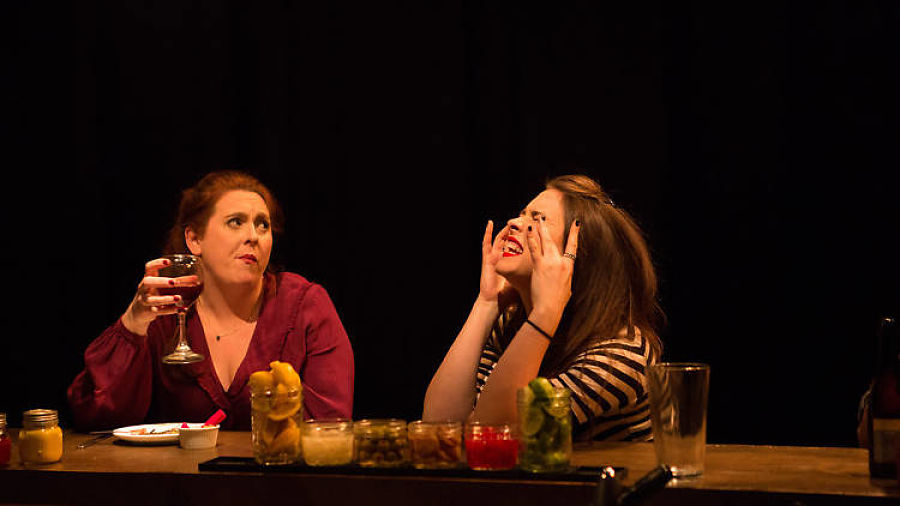
I’m Very Into You (Special Effects): Though it’s a work-in-progress and not open for review, Sara Lyons’s epistolary play, based on the published 1995 emails of the late Kathy Acker, is worth keeping an eye out for in the future. Acker had a “three-day stand” with Australian academic McKenzie Wark, and the two followed up that dalliance with intense and flirty emails across the Pacific. This is no ordinary romance, as they analyze the nature of sexual power games and their own queer identities. These academic writers tussle with the challenges of communicating their desires—being too honest or blunt, misconstruing each other, untangling meaning, and battling their own complicated minds in the process.
Blueprint Specials (Under the Radar): Created during World War II, a series of musical “kits” (with music by then-Pvt. Frank Loesser) provided the tools for military units to put on their own shows when USO celebrity entertainment could not reach them. In this production by Waterwell, both civilian actors and military personnel reconstruct these perform skits about military bureaucracy, sexual hygiene, and romance. The quick and silly vignettes might be quaintly outmoded, but when the cast appears for a curtain call in either their civilian clothes or military uniforms, it’s hard not to see the value in the endeavor. You may be surprised to discover, for instance, which were the talented military performers and which civilians. We are often blind to the sacrifices of our armed service personnel, and this show is a gentle reminder that there many walk among us. Among the standout performances in the UTR production were military singer Emily McAleesjergins and civilian Quinn Mattfeld, who has ace comedic timing.

Lula del Ray (Under the Radar): Manual Cinema presents a fanciful tale of a teenager obsessed with space travel who then shifts her fangirl energy to a rockabilly duo. The lure of seeing her musical heroes proves too great and she runs away to the big city in hopes of finding them. This company, which employs the concept of “live” cinema using puppets, live actors, props, live music, and overhead projections, conjures a dreamy world. From Lula’s rural trailer alongside massive satellite dishes to the unfriendly city, the artists create a distinct sense of place and a vivid character in the headstrong Lula. Though it perhaps adds a few too many minutes to the evening, the labor-intensive process by which the piece is put together, on full display to the audience, proves a fascinating act unto itself.
To all these artists: I’m available next January to provide out-of-sync dancing, hammer objects into shards, or any other experimental theatre tasks you dream up. But I’m also happy just to watch.
Nicole Serratore is a freelance critic and writer for The Village Voice, The Stage (UK), American Theatre, and she serves as an editor and writer for Exeunt magazine.

